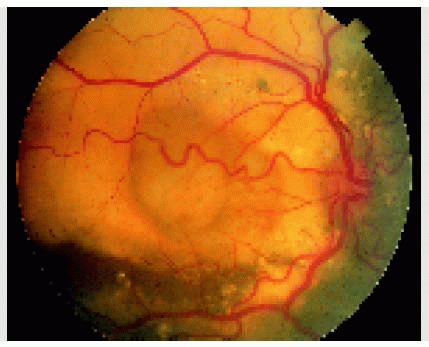 Lesions That Can Simulate Retinoblastoma
Lesions That Can Simulate RetinoblastomaLesions Simulating Retinoblastoma
Several conditions can resemble retinoblastoma by causing a white fundus lesion and/or by causing leukocoria (1, 2, 3, 4, 5, 6, 7, 8, 9, 10, 11, 12, 13, 14, 15, 16, 17, 18, 19, 20, 21, 22, 23, 24-25). The clinician should be familiar with these conditions and the features that serve to differentiate them clinically from retinoblastoma. Many simulating lesions are other tumors, like astrocytic hamartoma, medulloepithelioma, and combined hamartoma, and they are covered mainly in other chapters; they are briefly mentioned here in the context of their similarities to retinoblastoma. This chapter describes primarily some nonneoplastic conditions that can simulate retinoblastoma. These conditions are classified as follows:
Hereditary conditions
Norrie disease
Congenital retinoschisis
Incontinentia pigmenti
Dominant exudative vitreoretinopathy
Developmental abnormalities
Persistent hyperplastic primary vitreous
Congenital cataract
Coloboma
Retina dysplasia
Congenital retinal fold
Myelinated nerve fibers
Morning glory syndrome
Inflammatory disorders
Ocular toxocariasis
Congenital toxoplasmosis
Congenital cytomegalovirus retinitis
Herpes simplex retinitis
Peripheral uveoretinitis
Metastatic endophthalmitis
Orbital cellulitis
Tumors
Retinal astrocytic hamartoma
Medulloepithelioma
Glioneuroma
Choroidal hemangioma
Retinal capillary hemangioma
Combined retinal hamartoma
Leukemia
Miscellaneous
Coats disease
Retinopathy of prematurity
Rhegmatogenous retinal detachment
Vitreous hemorrhage
This comprehensive list does not reflect the frequency of these lesions in a clinical practice. In a series of 500 patients referred with the diagnosis of possible retinoblastoma, 288 proved on subsequent evaluation to have retinoblastoma and 212 proved to have simulating lesions (3,4). The three conditions that most closely simulated retinoblastoma were persistent hyperplastic primary vitreous (PHPV) (28%), Coats disease (16%), and inflammation, usually ocular toxocariasis (16%). Since the publication of those articles, Coats disease has passed PHPV as the most frequent pseudoretinoblastoma, and ocular toxocariasis has become much less frequent in our practice. The specific clinical features that help to differentiate these conditions are discussed in detail in the literature (1, 2, 3, 4, 5, 6, 7, 8, 9, 10, 11, 12, 13, 14, 15, 16, 17, 18, 19, 20, 21, 22, 23) and are summarized in the following plates.
Selected References
1. Shields JA, Shields CL. Differential diagnosis of retinoblastoma In: Shields JA, Shields CL. Intraocular Tumors. A Text and Atlas. Philadelphia: WB Saunders; 1992:341-362.
2. Howard GM, Ellsworth RM. Differential diagnosis of retinoblastoma. A statistical survey of 500 children. I. Relative frequency of the lesions which simulate retinoblastoma. Am J Ophthalmol 1965;60:610-618.
3. Shields JA, Parsons HM, Shields CL, et al. Lesions simulating retinoblastoma. J Pediatr Ophthalmol Strabismus 1991;28:338-340.
4. Shields JA, Shields CL, Parsons HM. Review: differential diagnosis of retinoblastoma. Retina 1991;11:232-243.
5. Kogan L, Boniuk M. Causes for enucleation in childhood with special reference to pseudogliomas and unsuspected retinoblastoma. Int Ophthalmol Clin 1962;2:507-514.
6. Robertson DM, Campbell RJ. An analysis of misdiagnosed retinoblastoma in a series of 726 enucleated eyes. Mod Probl Ophthalmol 1977;18:156-159.
7. Margo CE, Zimmerman LE. Retinoblastoma: the accuracy of clinical diagnosis in children treated by enucleation. J Pediatr Ophthalmol Strabismus 1983;20:227-229.
8. Shields JA, Michelson JB, Leonard BC, et al. B-scan ultrasonography in the diagnosis of atypical retinoblastomas. Can J Ophthalmol 1976;11:42-51.
9. Ridley ME, Shields JA, Brown GC, et al. Coats’ disease. Evaluation of management. Ophthalmology 1982;89:1381-1387.
10. Jaffe MS, Shields JA, Canny CLB, et al. Retinoblastoma simulating Coats’ disease. Ann Ophthalmol 1977;9:863-868.
11. Shields JA, Shields CL. Differentiation of Coats’ disease and retinoblastoma. J Pediatr Ophthalmol Strabismus 2001;38:262-266.
Stay updated, free articles. Join our Telegram channel

Full access? Get Clinical Tree


